I have done a lot of scattered baking the past two months. These are pics of most of it. OK, so only one loaf was actually bad. That was the one where I thought I forgot to add the salt to the evening mix, so I added it the next morning. That was one of Peter Reinhart’s epoxy sandwich loaves. Not only was it too salty, but as you can guess it also didn’t rise very well. It still had a very nicely textured crumb. That loaf went in the freezer for use as breadcrumbs. I just hope I remembered to label it!
~~~~~~~~~~~~~~~~~~~~~~~~~~~~~~~~~~~~~~~~~~~~~~~~~~~~~~~~~~~~~~~~~~
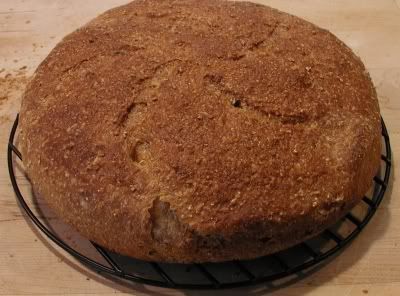
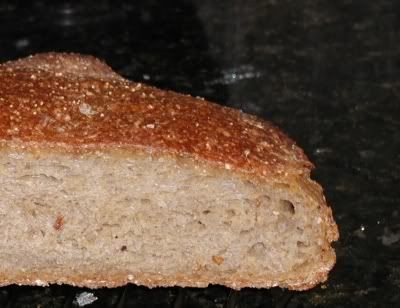
07/29/07 This was a wonderfully flavorful multigrain loaf, based on the NYT/Lahey No Knead Bread. Thanks Cooky for the grains combination! I couldn’t find my cornmeal, so used corn grits instead. I didn’t presoak any of the grains, but with the 18 hour ferment they did fine. I didn’t get well-developed gluten, but for the minimum effort involved, I was happy, and the taste was great.
A few days later, I diced up the remainder and used it for a cheesy bread pudding. Topped with the bacon/tomato/onion flavors of bluezebra’s mulligan stew it made a very nice light supper.
1/3 cup rye flour
1/3 cup steel cut oats
1/3 cup cornmeal
1/2 cup WW flour
1-1/2 cup bread flour
1 Tbsp gluten
1.5 tsp table salt (or 2 tsp kosher salt)
1/4 tsp yeast
1.5 cups water (more?)
~~~~~~~~~~~~~~~~~~~~~~~~~~~~~~~~~~~~~~~~~~~~~~~~~~~~~~~~~~~~~~~~~~
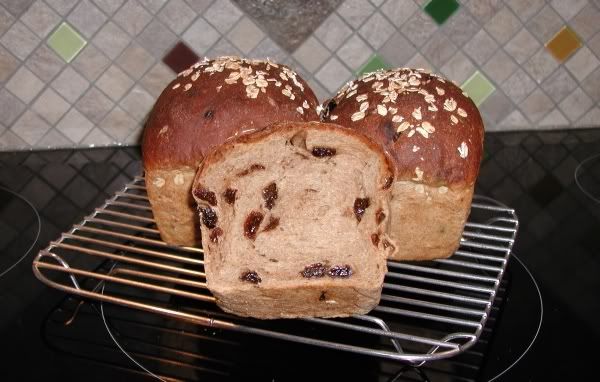
09/27/07 This is the cinnamon oatmeal raisin bread that so many of us know and love. I could have done a better job of mixing the raisins in, but am otherwise very happy with it. I’ll be making this often, freezing it in half-loaf portions. Eventually I hope to have large volume formulas I’m happy with for other breads, so I can keep the freezer stocked with a variety of breads. Yes, three loaves is large volume for me! The Delonghi/Kenwood mixer handled the full recipe just fine.
I subbed in 214 gr sourdough starter for corresponding amounts of flour and water, and added 1 Tbsp. granular lecithin to the dough. Both of these were to enhance the keeping quality. I also took the dough for the third loaf, and made cinnamon rolls from it. They were baked with more butter, sugar and cinnamon, and topped with icing. But I thought the plain bread was better.
~~~~~~~~~~~~~~~~~~~~~~~~~~~~~~~~~~~~~~~~~~~~~~~~~~~~~~~~~~~~~~~~~~

09/15/07 The loaf on the left is Peter Reinhart’s transitional rye sandwich loaf on page 119. I did increase the content of whole wheat flour relative to bread flour just a bit. The loaf on the right is a quickly thrown together NYT/Lahey no-knead rye bread. I wanted to try the King Arthur deli rye flavor, but didn’t want to adulterate the taste of the rye sandwich loaf. I don’t think I quite got the perfect formula for the no-knead! But it was still a good bread.
The taste comparison was interesting. A few hours after the bread was baked, we thought the PR loaf was a bit sweet, and preferred the flavor of the other one. The next day, we noticed more complex flavors in the PR loaf, and preferred it. Next time I may try the PR loaf with the King Arthur flavor enhancer.
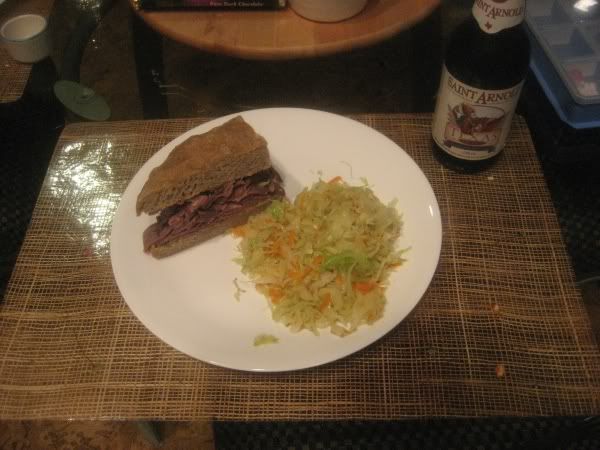
The flat no knead rye made a nice hearty sandwich
~~~~~~~~~~~~~~~~~~~~~~~~~~~~~~~~~~~~~~~~~~~~~~~~~~~~~~~~~~~~~~~~~~
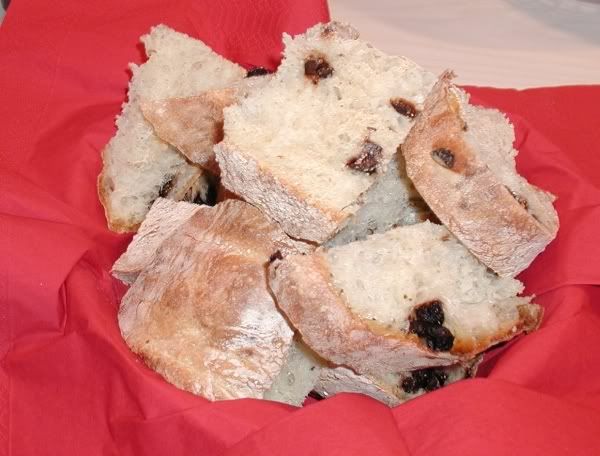
08/11/07 I played around a lot with the NYT/Lahey no knead. This one has kalamata olives, parmesan and marjoram. Unfortunately, there was no rosemary in the house. The bread was still good, and eaten with an Italian chicken dish. I also love it for tunafish sandwiches.
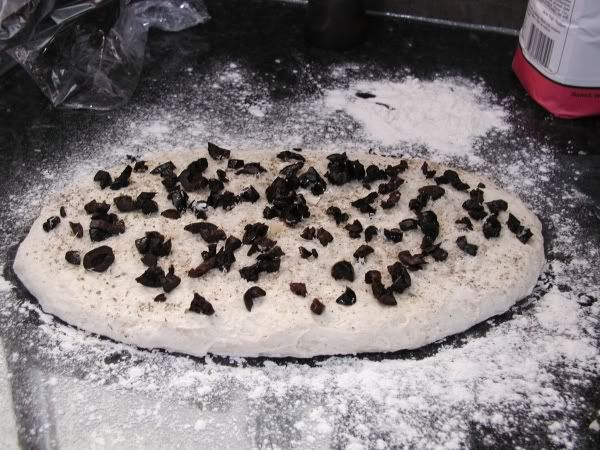
The bread additions were decided on rather late in the process, so I spread out the dough, topped with the additions, and rolled it up. I then did a few folds. This was NOT a good way to get the olives evenly distributed!
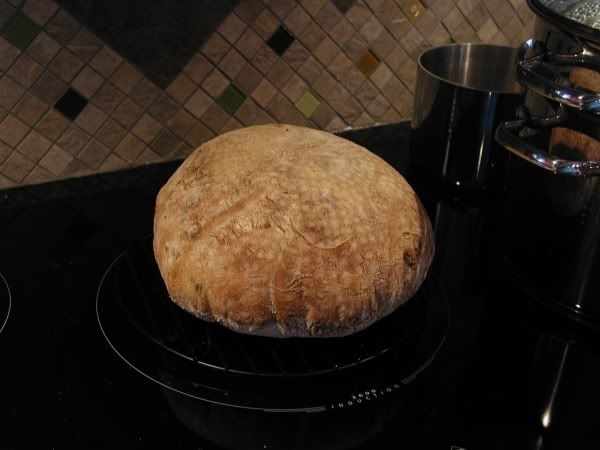
The result was a dough that wasn’t developed quite enough. As you can see, it has a lot of puff at the top.
~~~~~~~~~~~~~~~~~~~~~~~~~~~~~~~~~~~~~~~~~~~~~~~~~~~~~~~~~~~~~~~~~~
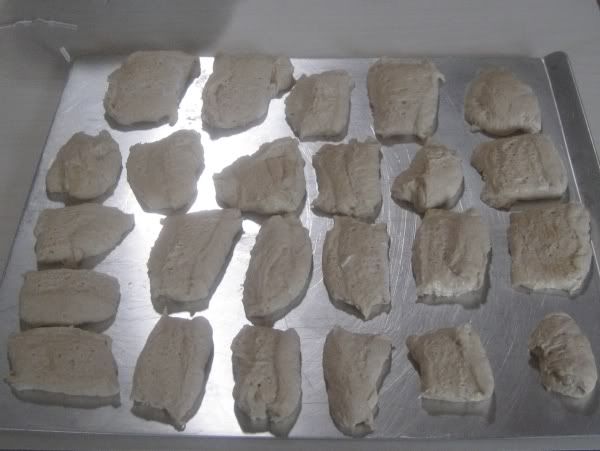
09/??/07 One of my uses for some leftover starter was some sourdough biscuits. I didn’t get the formula right – and my starter was probably too old to use.
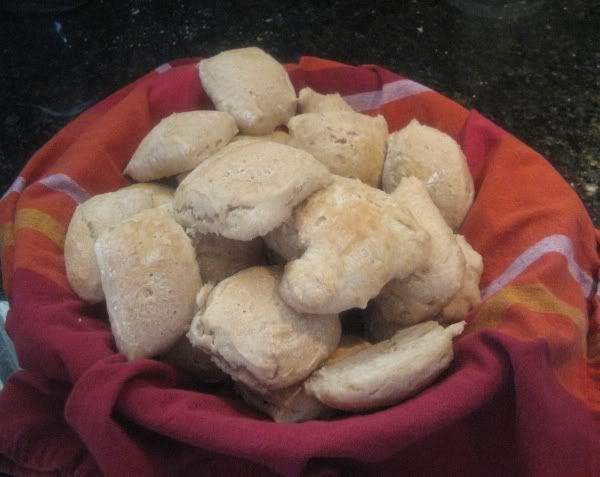
So they weren’t perfect biscuits, but were definitely tasty!
~~~~~~~~~~~~~~~~~~~~~~~~~~~~~~~~~~~~~~~~~~~~~~~~~~~~~~~~~~~~~~~~~~
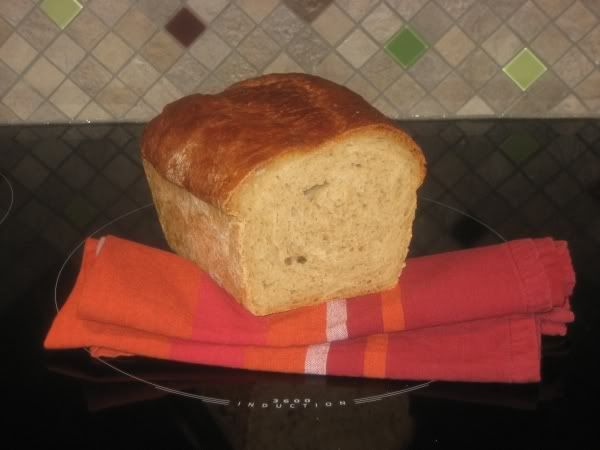
09/08/07 I think this is the Loaf for Learning from Laurel’s Kitchen. It was a good effort, with a nice soft crumb but my version still has room for improvement. Definitely worth a 2nd try.
~~~~~~~~~~~~~~~~~~~~~~~~~~~~~~~~~~~~~~~~~~~~~~~~~~~~~~~~~~~~~~~~~~

08/20/07 This is the sandwich loaf from Reinhart’s new book, Whole Grain Breads. Too bad about that salt!
~~~~~~~~~~~~~~~~~~~~~~~~~~~~~~~~~~~~~~~~~~~~~~~~~~~~~~~~~~~~~~~~~~

08/09/07 This is my earlier attempt at almost the same loaf. This time I had used JMonkey’s version.
I will try this one more time. Sure hope the third time’s the charm!
~~~~~~~~~~~~~~~~~~~~~~~~~~~~~~~~~~~~~~~~~~~~~~~~~~~~~~~~~~~~~~~~~~

08/30/07 I took a basic NYT/Lahey no-knead, gave it a few extra folds, and tried a sandwich-loaf shape. It didn’t have quite enough structure. You can see it pushed out the rolling pins I used to hold my “couche” in place.

It still made a very tasty loaf, and was good for sandwiches. You can see how it laughed at my slashes! More than likely I won't try this formula like this again - either go with the utter simplicity of the original, or make a bread designed to hold up to shaping. But I had fun finding out if it would work.
~~~~~~~~~~~~~~~~~~~~~~~~~~~~~~~~~~~~~~~~~~~~~~~~~~~~~~~~~~~~~~~~~~

08/06/07 This is about a half recipe of the NYT/Lahey loaf, small enough to fit easily in my toaster oven.
~~~~~~~~~~~~~~~~~~~~~~~~~~~~~~~~~~~~~~~~~~~~~~~~~~~~~~~~~~~~~~~~~~
08/04/07 This is my first whole wheat sourdough. I started following instructions for a mixer far less powerful than mine, and way overkneaded the dough.
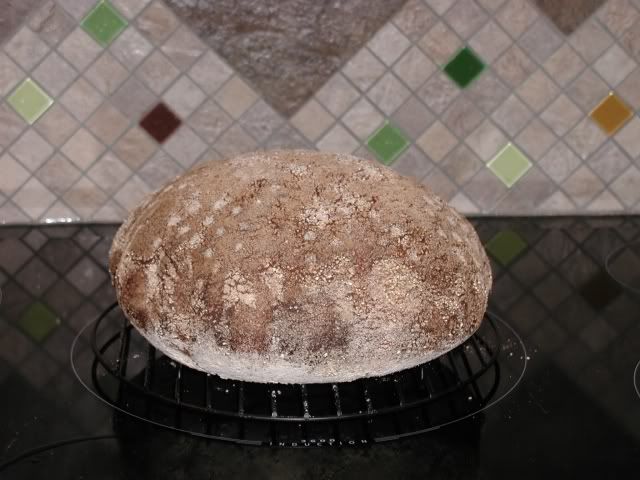
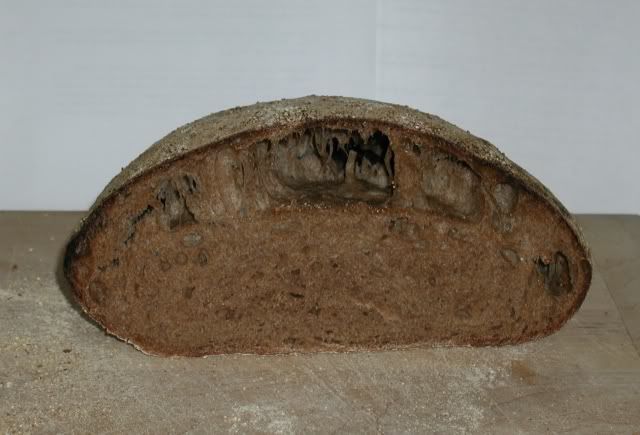
I thought I had great ovenspring, but just had these huge baker’s caves (Surely some bakers lived in caves sometime.) Anyway, you’ll find a discussion of much that went wrong HERE.
400 g starter (about 100% - mostly WW with some rye & AP)
480 g WW flour
420 g water
1.25 teaspoons table salt
~~~~~~~~~~~~~~~~~~~~~~~~~~~~~~~~~~~~~~~~~~~~~~~~~~~~~~~~~~~~~~~~~~
Well, that’s all the pics. We also had pizza a few times, but I always forgot to snap a photo. Some of the breads were also consumed without benefit of camera. ;~) Extra starter went into cornbread and a few batches of waffles. The cornbread tasted about the same as normal. I don’t know how the waffles compared, because I hadn’t made them in years! The desire to use extra starter triggered all sorts of things. I may do pancakes next weekend.
I’ve had a very chaotic summer, and baked way more than we need to eat. Yes, we gave some away, but also ate too much. Time for me to get back to doing some things I’ve been ignoring and bake a little less. Both my office and my waistline will appreciate it!